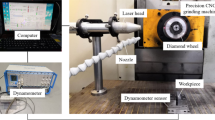Abstract
In this paper, the effect of additive particles on the mechanical properties of ultraviolet (UV)-cured resin was evaluated based on tensile strength and shear strength. The experimental results showed that the tensile strength was improved with proper particle addition, but the shear strength was always decreased. Moreover, the effects of additive particles on the holding force of diamond abrasive, critical exposure energy, and penetration depth of UV-cured resin were elucidated. The holding force of resin with 15 wt.% Al2O3 addition was found to be higher than that of pure UV resin. Based on the experimentally determined critical UV exposure energy and penetration depth, UV-cured resins with and without additive particles were used to fabricate grinding wheels using additive manufacturing technology. Grinding experiment demonstrated the performance of UV resinoid grinding wheels was significantly improved with the addition of 15 wt.% Al2O3 particles.
Similar content being viewed by others
References
Zhigalov RV, Gusev VG, Miroshkina NN (2013) Vibration of segmented grinding wheels under an external load. Int J Adv Manuf Technol 33(11):672–673. https://doi.org/10.3103/S1068798X13110191
Turssi CP, Ferracane JL, Serra MC (2005) Abrasive wear of resin composites as related to finishing and polishing procedures. Dent Mater 21(7):641–648. https://doi.org/10.1016/j.dental.2004.10.011
Tong S, Gracewski SM, Funkenbusch PD (2006) Measurement of the Preston coefficient of resin and bronze bond tools for deterministic microgrinding of glass. Precis Eng 30(2):115–122. https://doi.org/10.1016/j.precisioneng.2005.03.004
Lin AC, Gian R (1999) Multiple-tool approach to rough machining of sculptured. Int J Adv Manuf Technol 15:387–398. https://doi.org/10.1007/s001700050081
Jackson MJ (2017) Analysis of rectangular-profiled high-strength grinding wheels designed for crankshaft grinding applications. Int J Adv Manuf Technol 95(2–3):1–17. https://doi.org/10.1007/s00170-017-1449-9
Bomo J, Ezan F, Tiaho F, Bellamri M, Langouet S, Theret N, Baffet G (2016) Increasing 3D matrix rigidity strengthens proliferation and spheroid development of human liver cells in a constant growth factor environment. J Cell Biochem 177(3):708–720. https://doi.org/10.1002/jcb.25356
Im YG, Chung SI, Son JH, Jung YD, Jo JG (2002) Functional prototype development: inner visible multi-color prototype fabrication process using stereo lithography. J Mater Process Technol 130(02):372–377. https://doi.org/10.1016/S0924-0136(02)00826-9
Bakarich SE, Gorkin RI, Panhuis MIH, Spinks GM (2014) Three-dimensional printing fiber reinforced hydrogel composites. Acs Appl Mater Interfaces 6(18):15998–16006. https://doi.org/10.1021/am503878d
Lam CXF, Mo XM, Teoh SH, Hutmacher DW (2002) Scaffold development using 3D printing with a starch-based polymer. Mat Sci Eng C 20(1):49–56. https://doi.org/10.1016/S0928-4931(02)00012-7
Tanaka T, Isono Y (2001) New development of a grinding wheel with resin cured by ultraviolet light. J Mater Process Technol 113(1):385–391. https://doi.org/10.1016/S0924-0136(01)00636-7
Martin B, John P, Wruck L, Osswald TA (2017) Degree of cure of epoxy/acrylic photopolymers: characterization with Raman spectroscopy and a modified phenomenological model. Polym Eng Sci 58:228–237. https://doi.org/10.1002/pen.24550
Li WK, Dichiara A, Bai JB (2013) Carbon nanotube–graphene nanoplatelet hybrids as high-performance multifunctional reinforcements in epoxy composites. Compos Sci Technol 74(4):221–227. https://doi.org/10.1016/j.compscitech.2012.11.015
Hague R, Mansour S, Saleh N, Harris R (2004) Materials analysis of stereolithography resins for use in rapid manufacturing. J Mat Sci 39(7):2457–2464. https://doi.org/10.1023/B:JMSC.0000020010.73768.4a
Shang SW, Williams JW, Soderholm KJM (1995) Work of adhesion influence on the rheological properties of silica filled polymer composites. Mater Sci 30(17):4323–4334. https://doi.org/10.1007/BF00361512
Corcione CE, Striani R, Montagna F, Cannoletta D (2014) Organically modified montmorillonite polymer nanocomposites for stereolithography building process. Polym Advan Technol 26(1):647–659. https://doi.org/10.1002/pat.3425
Gurr M, Hofmann EM, Yi T (2010) Acrylic nanocomposite resins for use in stereolithography and structural light modulation based rapid prototyping and rapid manufacturing technologies. Adv Funct Mater 18(16):2390–2397. https://doi.org/10.1002/adfm.200800344
Cheah CM, Fuh JYH, Nee AYC, Lu L (1999) Mechanical characteristics of fiber-filled photo-polymer used in stereolithography. Rapid Prototyping J 5(3):112–119. https://doi.org/10.1108/13552549910278937
Wajid AS, Ahmed THS, Das S, Irin F, Jankowski AF, Green MJ (2013) High-performance pristine graphene/epoxy composites with enhanced mechanical and electrical properties. Macromol Mater Eng 298(3):339–347. https://doi.org/10.1002/mame.201200043
Chin Y, Tyas M, Goldman M (1987) The bond strength of incrementally laced composite resin. Aust Dent J 32(4):247–251. https://doi.org/10.1111/j.1834-7819.1987.tb04148.x
Fuh JYH, Choo YS, Nee AYC, Lu L, Lee KC (1995) Improvement of the UV curing process for the laser lithography technique. Mater Des 16(1):23–32. https://doi.org/10.1016/0261-3069(95)00007-L
Acknowledgments
The authors are especially grateful for the helpful discussion and suggestion provide by Prof. Dekui Mu at the Huaqiao University in China.
Funding
The authors would like to acknowledge the support of the National Natural Science Foundation of China (NSFC) (Grant Nos. 51235004 and 51375179) and Science and Technology Projects of Fujian Province (2017H6014).
Author information
Authors and Affiliations
Corresponding author
Rights and permissions
About this article
Cite this article
Qiu, Y., Huang, H. & Xu, X. Effect of additive particles on the performance of ultraviolet-cured resin-bond grinding wheels fabricated using additive manufacturing technology. Int J Adv Manuf Technol 97, 3873–3882 (2018). https://doi.org/10.1007/s00170-018-2231-3
Received:
Accepted:
Published:
Issue Date:
DOI: https://doi.org/10.1007/s00170-018-2231-3




